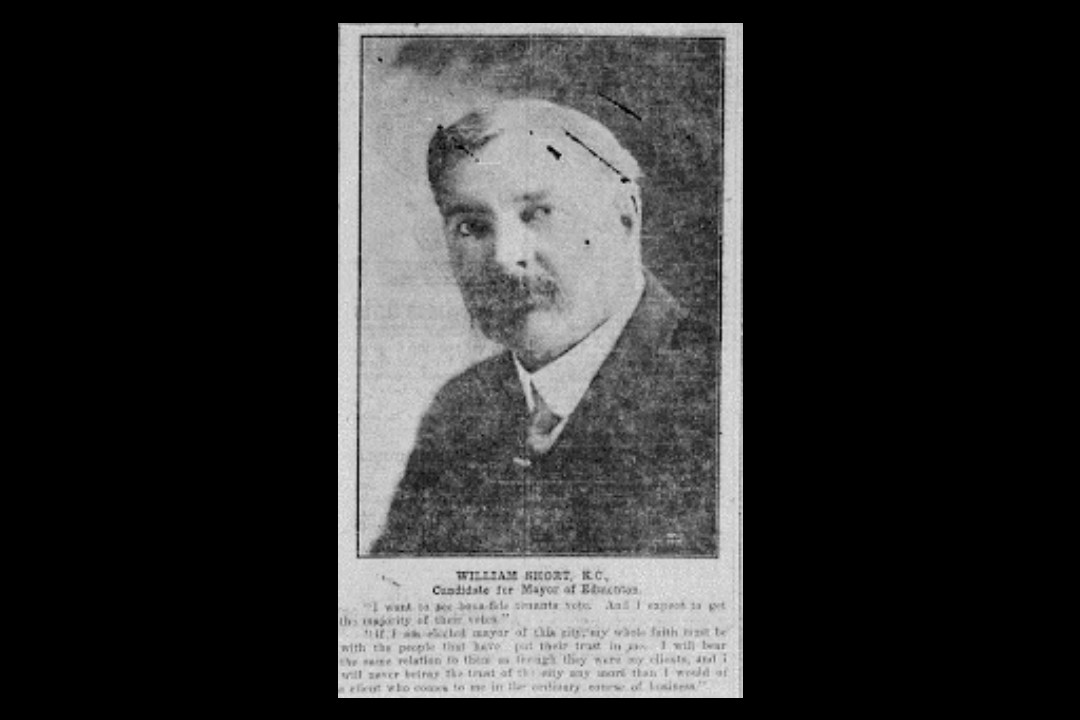On this day in 1912, William Short was aiming to be the mayor of Edmonton once again. While most former mayors have left a mark on the city, Short was in power during several significant moments in Edmonton's history.
Short was born in 1866 in Canada West (now Ontario). He moved to Edmonton as a young man in 1889 and was called to the bar a few years later. By 1901, Short had already dabbled in politics, including serving as a public school trustee for a couple of years, when he chose to run for mayor. No one ran against him, so Short was acclaimed.
Soon after, Short oversaw his first vital moment in Edmonton's history — the arrival of the first passenger train. Even though the Edmonton-Calgary Railway had by this time existed for more than a decade, trains never actually stopped in Edmonton. Instead, the line ended in Strathcona to save the cost of building a bridge over the river. Many assumed that without a rail connection, Edmonton would eventually be overtaken by Strathcona, its neighbour on the south side of the river.
Instead, the Edmonton, Yukon & Pacific Railway was established, using the Low Level Bridge to link Edmonton to the south side of the river. Trains rolled across the bridge in 1902. Short declared the day a civic holiday.
Back then, Edmonton's elections were an annual affair. Short was acclaimed mayor again in 1902. In 1903, he won his first contested race, taking 277 votes to his opponent's 246.
Edmonton was granted city status in 1904, meaning Short was the first mayor of the City of Edmonton. As mayor, Short wrote Edmonton's original city charter. That same year, Short met with officials from the Canadian Pacific Railway to propose the idea of building another rail bridge into Edmonton. These were the first steps toward the construction of the High Level Bridge.
Short didn't seek re-election in 1904, but he wasn't completely done with the idea of being mayor. Almost a decade later, in 1912, Short ran again and won. Once again, Short was in power as Edmonton's relationship with Strathcona was changing. In 1912, the two cities were amalgamating into one entity. One of the big questions arising from the merger was street names—the two cities used widely different methods. Several plans were proposed, including one Short came up with to see Edmonton use a grid system of numbered streets, with Jasper Avenue as 101 Street. The plan was controversial. Many opposed it, including the city's engineer, and many aldermen. Short ignored those protests, purposefully cut out some of his opponents, and pushed his plan forward. It was eventually approved by a plebiscite in 1913. Short won the fight over street names but it likely cost him the next election. In 1913, he lost to William J. McNamara by 36 votes. So, not only does Short hold the distinction of being the first mayor of the City of Edmonton, he was also the first incumbent mayor to lose.
Short doesn't have parks and stadiums named after him like many former mayors. There is, ironically, simply a William Short Road in his honour. But the impact of his time leading Edmonton is clear to see in the numbered streets and former railway bridges that Edmontonians travel daily. In October 2025, voters will decide on the city's next mayor. Coun. Tim Cartmell has announced he's running. Current mayor Amarjeet Sohi has not yet announced whether he plans to run for re-election.
This clipping was found on Vintage Edmonton, a daily look at Edmonton's history from armchair archivist @revRecluse of @VintageEdmonton.

